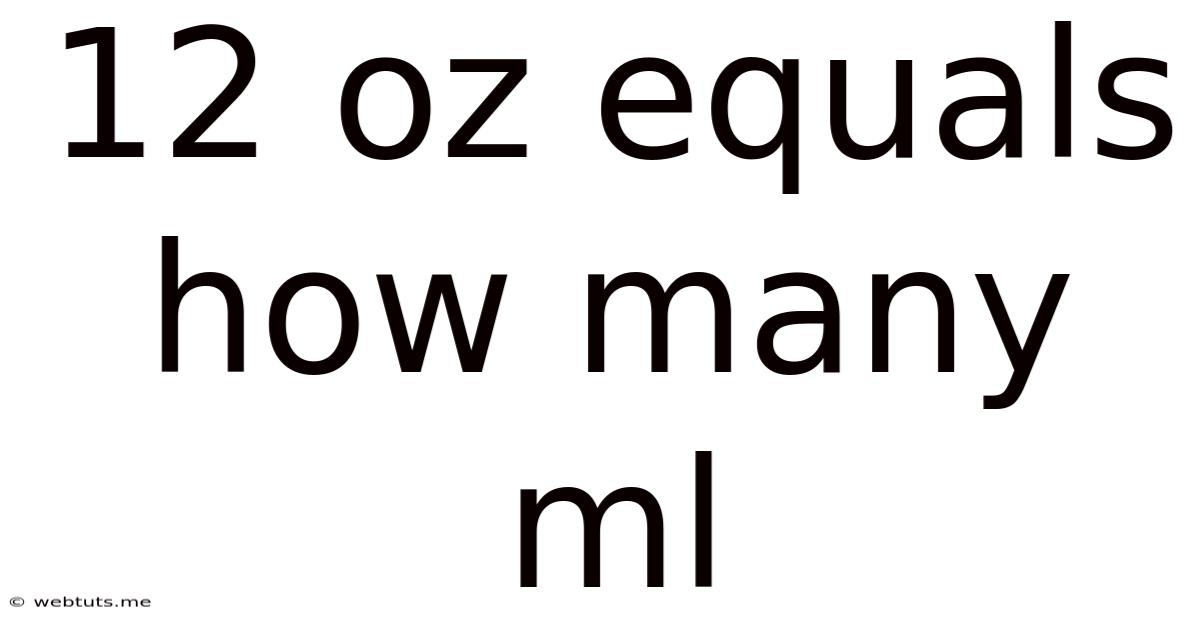12 Oz Equals How Many Ml
Webtuts
May 12, 2025 · 4 min read

Table of Contents
12 oz Equals How Many mL? A Comprehensive Guide to Fluid Ounce Conversions
Knowing how to convert fluid ounces to milliliters is a crucial skill for anyone working with recipes, scientific experiments, or even everyday tasks involving liquids. This comprehensive guide will delve deep into the conversion of 12 fluid ounces to milliliters, explaining the process, providing accurate calculations, and exploring the nuances of volume measurement. We'll also touch upon the different types of ounces and potential sources of error in conversions.
Understanding Fluid Ounces and Milliliters
Before diving into the conversion, it's essential to understand the units involved.
Fluid Ounces (fl oz)
A fluid ounce (fl oz) is a unit of volume in the imperial and US customary systems. It's important to note that there are slight differences between the US fluid ounce and the imperial fluid ounce, leading to slightly different conversion factors. This difference is often negligible in many everyday situations, but it's crucial to be aware of it for precise scientific or medical applications. We'll primarily focus on the US fluid ounce in this article unless otherwise specified.
Milliliters (mL)
A milliliter (mL) is a unit of volume in the metric system. It's a thousandth of a liter (1/1000 L). The metric system's decimal-based nature makes conversions within the system relatively straightforward.
Converting 12 Fluid Ounces to Milliliters
The key to converting fluid ounces to milliliters is the conversion factor. One US fluid ounce is approximately equal to 29.5735 milliliters. Therefore, to convert 12 fluid ounces to milliliters, we simply multiply:
12 fl oz * 29.5735 mL/fl oz ≈ 354.882 mL
Therefore, 12 fluid ounces is approximately equal to 354.88 milliliters.
Rounding and Precision
The exact conversion yields a number with several decimal places. The level of precision needed depends on the context. For most cooking or baking purposes, rounding to one or two decimal places (354.88 mL) is sufficient. For scientific applications, however, more decimal places may be necessary to maintain accuracy.
Practical Applications of the Conversion
Understanding this conversion is crucial in various scenarios:
Cooking and Baking
Many recipes, particularly those originating from the US, use fluid ounces as a unit of measurement. If you're working with a metric measuring system, you'll need to convert these measurements. Knowing that 12 fl oz is roughly 355 mL allows for accurate conversions when following recipes.
Scientific Experiments and Research
In scientific settings, precise measurements are critical. Converting between fluid ounces and milliliters ensures consistent and accurate results, especially in experiments involving liquids. The use of the correct conversion factor is paramount to maintain data integrity.
Medicine and Healthcare
Dosage instructions for certain medications may be given in fluid ounces. Converting these amounts to milliliters can be necessary for accurate administration, particularly in situations where precise measurements are critical for patient safety and efficacy.
Everyday Life
Even in everyday situations, understanding this conversion can be useful. From measuring liquids for cleaning solutions to understanding the volume of beverages, the ability to convert between fluid ounces and milliliters simplifies everyday tasks.
Potential Sources of Error in Conversions
While the conversion process is straightforward, several factors can contribute to errors:
Inconsistent Measurement Tools
Using inaccurate measuring cups or tools can lead to significant errors in conversions. Always ensure your measuring tools are calibrated accurately.
Rounding Errors
Rounding off numbers during the conversion process can lead to cumulative errors, especially when dealing with multiple conversions. It's best to retain as many decimal places as possible during calculations before rounding the final result.
Differences between US and Imperial Fluid Ounces
As mentioned before, a subtle difference exists between US and imperial fluid ounces. Using the wrong conversion factor will lead to inaccurate results. Always be clear about which fluid ounce you're working with (US or imperial).
Temperature Effects
Temperature can affect the volume of liquids, potentially influencing the accuracy of conversions. While this effect is generally minor in many everyday situations, it can be significant in highly precise scientific experiments.
Beyond 12 Fluid Ounces: Mastering Fluid Ounce to Milliliter Conversions
Understanding the conversion of 12 fluid ounces to milliliters provides a solid foundation for converting other fluid ounce measurements to milliliters. The basic principle remains the same: multiply the number of fluid ounces by the appropriate conversion factor (approximately 29.5735 mL/fl oz for US fluid ounces).
Here are some examples:
- 6 fl oz: 6 * 29.5735 mL/fl oz ≈ 177.44 mL
- 16 fl oz: 16 * 29.5735 mL/fl oz ≈ 473.176 mL
- 24 fl oz: 24 * 29.5735 mL/fl oz ≈ 709.764 mL
By mastering this fundamental conversion, you can confidently navigate various scenarios involving volume measurements, ensuring accuracy and precision in your work.
Conclusion: The Importance of Accurate Volume Conversions
The ability to accurately convert between fluid ounces and milliliters is an invaluable skill with wide-ranging applications. Whether in the kitchen, the laboratory, or everyday life, understanding this conversion ensures precision, consistency, and success in various tasks. By following the guidelines presented in this article and paying close attention to detail, you can confidently and accurately convert fluid ounces to milliliters every time. Remember to always consider the context of the conversion and the appropriate level of precision required for accurate results.
Latest Posts
Latest Posts
-
How Many Days Until August 8 2025
May 14, 2025
-
8 Cubic Yards To Cubic Feet
May 14, 2025
-
How Many Meters In A Square Mile
May 14, 2025
-
180 Days From June 27 2024
May 14, 2025
-
800 Mg Is How Many Grams
May 14, 2025
Related Post
Thank you for visiting our website which covers about 12 Oz Equals How Many Ml . We hope the information provided has been useful to you. Feel free to contact us if you have any questions or need further assistance. See you next time and don't miss to bookmark.